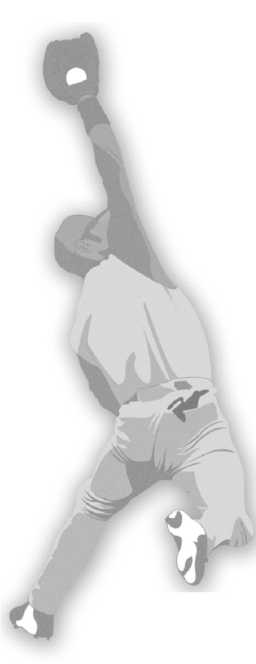The New Ballgame: Understanding Baseball Statistics for the Casual Fan (11 page)
Read The New Ballgame: Understanding Baseball Statistics for the Casual Fan Online
Authors: Glenn Guzzo

When Bruce Sutter was
inducted into the Hall of
Fame in 2006, he was the
first "pure" reliever to earn
the honor. Three other
pitchers-Hoyt Wilhelm,
Rollie Fingers and Dennis
Eckersley-owe their
enshrinement to their
relief pitching, but all had
been starting pitchers
for part of their careers.
Sutter is the only pitcher
in the Hall never to have
started a game.
Here's another deception: "Joe (insert any name here) has hit safely in
10 of his last 14 games." Yeah. But is he hitting well? Take those two 0-for-5s
and two 0-for-4s, add six 1-for-4s, two 1-for-3s, a 2-for-3 and a 2-for-4 and it
turns out that Joe is hitting.218 during this "hot streak."A player can get a hit
every day for two weeks, but if it's a string of 1-for-4s, he's still hitting only
.250 during his streak.
When presented forthrightly, the good news can be useful.
A hitting streak may be mentionable when it reaches 10 consecutive games, interesting when it hits 20. It won't get national attention until
it reaches 30 because one of baseball's shiniest records is Joe DiMaggio's
56-game hitting streak in 1941-an achievement never seriously challenged.
(But note: Not only did Boston's Ted Williams out-hit New York's DiMaggio
that year, .406 to .357, Williams also hit for a higher average during DiMaggio's streak, .412 to .408.)
Here are a few of the most noteworthy streaks and single-game accomplishments that might be challenged someday at a ballpark near you:
• Most consecutive games with a home run: 8 by Yankee Don
Mattingly.
• Most consecutive hits: 12 by the Red Sox' Pinky Higgins and Tiger
Walt Dropo.
• Most consecutive scoreless innings pitched: 59 by Dodger Orel Her-
shiser in 1988, breaking the mark of 582/-1 innings by Dodger Don
Drysdale twenty years earlier.
• Most strikeouts in a game by a pitcher: 20 by the Red Sox' Roger
Clemens (twice), rookie Cub Kerry Wood in 1998, and Diamondback Randy Johnson.
• Most consecutive no-hitters: 2, four days apart in 1938 by Cincinnati
left-hander Johnny Vander Meer. Every time a pitcher throws a nohitter, everyone with a sense of baseball history watches to see if he
can do it the next time out.
The casual fan might be looking at the scoreboard often to find out who is
up and what he has done in his previous plate appearances today. Serious
fans, even those who already know this stuff because they're keeping score
themselves, will be looking at the scoreboard too, but for more detailed information:
• Decisions by the official scorer ("scoring decisions")
Was that pitch that got away a wild pitch (charged to the pitcher) or a
passed ball (charged to the catcher)? Was that sharp groundball that
popped out of the fielder's glove an error or a hit?
• Pitch information
Some scoreboards show whether the last pitch was a fastball, curve,
or other pitch. Some tally the number of strikes and balls this pitcher
has thrown so far today. Others display the velocity of the last pitch.
For most fans, the velocity recorded by a radar gun behind home
plate is entertainment. Many major league pitchers can throw fastballs at 90 mph. Some can hit 95. A very special few, such as relief
pitchers Billy Wagner and Eric Gagne, have hit 100. For fans on
higher alert, the velocity reveals many truths: Does this pitcher's
fastball have its usual speed? Is he able to sustain it? Is he mixing
speeds well to keep the batter off guard with an assortment of pitches
(fastball, curve, slider, changeup)? Have we reached the point in the
game where the pitcher is tiring and his velocity is falling?
• Out-of-town scores
Most big-league scoreboards show the scores of other games on the
same day. They show the inning and the jersey number of the pitcher.
Veteran "scoreboard watchers" may have an interest in many teams
and in certain pitchers performing elsewhere that day. Red Sox fans
are always interested in the fate of their arch-rival Yankees. Late in
the season, a game elsewhere may have strong impact on the pennant-race fortunes of a team in your park. And noticing when a team
has changed pitchers (the jersey number changes) can tip you off to
a rally by the other team.
Scoreboard watching is another reason to buy the game program. In
addition to the scorecard, and recent statistics for the teams playing at your
park that day, a good program will have identifying numbers for the pitchers
on out-of-town teams.

The big ballpark scoreboards won't help you when you overhear certain other conversations that might confuse you. Why is that guy rooting for
one Giants batter, then rooting against the next one? And what's this about the
pitcher ruining his WHIP? Those would be fans in fantasy-baseball leagues.
And over there: Those two guys agreeing that the shortstop is a 1, but the left
fielder is a 4? They play Strat-O-Matic, the baseball simulation game.
To keep up with those guys, you'll have to read more of this book.

 alk through the main gate of any
alk through the main gate of any
ballpark and you are immediately
bombarded from every angle by food stands,
beer carts, and souvenir shops-capitalist consumerism
on overdrive. With all this competition for your attention-and
your wallet-why should you keep your eyes and ears open for the wrinkled veteran vendor shouting, "Programs! Get your programs here!"
The answer is a simple grid almost always located right in the center
fold: the scorecard.
Fans keeping score at the ballpark get more out of being there. They
notice much more and anticipate strategy sooner than other fans. These fans will be the first to recognize that Roy Oswalt has retired eight batters in a row,
or struck out three of the last four men he's faced. They are much more likely
to see that Curt Schilling will have the advantage for the next three batters,
but after that-just when he's going to be hitting a vulnerable pitch count-he
reaches the part of the Yankee lineup that has been giving him trouble all day.
They can spot when Travis Hafner is dangerous despite being hitless, because
he's been pulling the ball hard today. They are alert to Ted Lilly getting into
trouble, despite throwing shutout innings, because of deep pitch counts that
will catch up to him sooner or later (probably sooner).
When a player has struck out three times, or gotten three straight hits
on the way to a cycle, some scoreboards will tell you that when he comes up
the next time. But nothing puts this into your awareness as well as writing it
down yourself.
Scorekeeping has endured because it is habit-forming. Being so aware
of the baseball before you is richly satisfying. Having a permanent record of
a memorable game is priceless.

Keeping score is as simple as you want it to be. Don't worry about doing it "right"-no two casual fans, "serious" fans, writers, broadcasters, or
team officials keep score exactly alike. Everyone has his or her own codes,
symbols and preferences. This chapter merely offers one suggested way to
keep score. You simply need to be able to track the progress of a team's inning
at-bat and to decipher your own codes later. If you can look at your scorecard
two weeks after the game and still know what happened, then you've done a
good job.
Here's how we'll help in this chapter:
• We'll present a basic system of keeping score, and offer you alternatives.
• We'll show how to add detail to your scorekeeping if you want that.
• We'll demonstrate by showing how Game Four of the 2006 World
Series would be scored in this system.
Scoresheets are grids. The lineup/batting order is listed vertically along the
left. Some scoresheets have a space to record each player's jersey number for
easy recognition. Most have a place to record the player's fielding position
(catcher, second base, etc.). Preferably, there are two or three lines for each
lineup spot. That permits easy entry of pinch hitters, pinch runners, and/or defensive replacements. Innings (at least nine, usually ten to twelve) are listed
horizontally across the top.
The result of this grid is a square for each inning to the right of each
player's name. When a player comes up in that inning, the results of his plate
appearance are recorded in that square.
On some scoresheets, those squares are blank. On others, a small diamond-shaped rectangle represents the bases the player might achieve. More
detailed scoresheets might also have spaces to record balls and strikes.
Now it's time to record what the batter did.
We want to show whether he got on base or made an out. If he hit the
ball, we want to show where it went.
Let's start with the outs.
Some scorekeepers are happy with symbols that simply show that a
batter popped out (PO), grounded out (GO), flied out (FO) or lined out (LO).
They will enter SAC for a sacrifice, SF for a sacrifice fly, and FC for a fielder's choice.
However, most people want to show who fielded the ball. There's a
universal code for all the different positions:
1-pitcher
2-catcher
3-first baseman
4-second baseman
5-third baseman
6-shortstop
7-left fielder
8-center fielder
9-right fielder
0-designated hitter
When a ball is caught in the air, it's sufficient to enter the number of the
fielder who caught the ball (e.g. "8" for a flyout to the center fielder). Such an
entry assumes a flyout to an outfielder or popout to an infielder.
If it's a line drive, you might want to put an "L" in front of the number
(e.g. "L4").
A ball caught in foul territory can be entered with a lower-case 'f'
(e.g. "f2." ).
A sacrifice fly is SF followed by the outfielder's position number (e.g.
SF7).
When a throw is necessary to retire the batter, both the throwing fielder (who
gets an assist) and the catching fielder (who gets a putout) are entered, separated by a hyphen.
